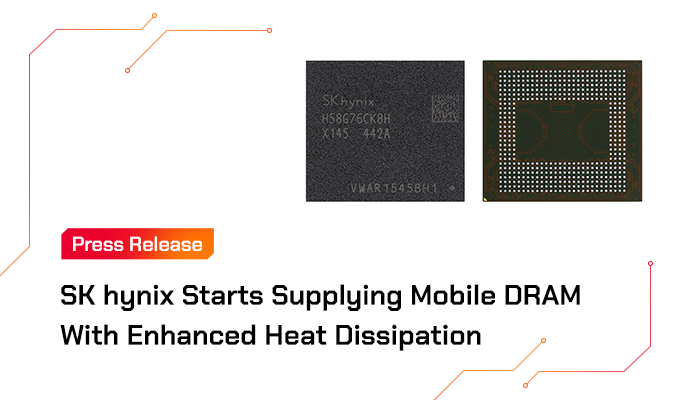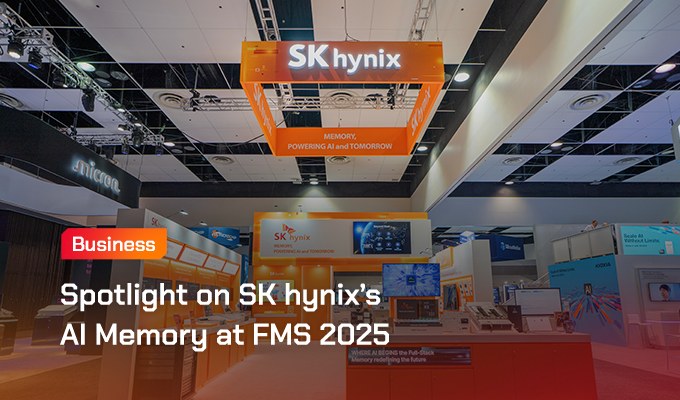On January 25, 2023, SK hynix announced it had developed the world’s fastest mobile DRAM, LPDDR5T (Low Power Double Data Rate 5 Turbo). Although the news came just two months after the company unveiled its predecessor LPDDR5X (Low Power Double Data Rate 5X), the new product offers significant improvements compared to the previous generation. LPDDR5T boasts unparalleled efficiency through its low-power and low-voltage characteristics as well as improving operating speeds. These advanced features were realized largely due to the application of the HKMG1 process, enabling SK hynix to lead the mobile DRAM market with LPDDR5T.
1HKMG process: A next-generation process that uses a high dielectric constant (K) material in the insulating film of the DRAM transistor to prevent leakage current and improve capacitance. It reduces power consumption while increasing speed. SK hynix introduced the world’s first HKMG process for mobile DRAM in November 2022.

Following the release of samples of the LPDDR5T, the development team sat down to discuss how they once again made the “first and best” product of its kind.

▲The developers of LPDDR5T gathered together to discuss how they improved the product’s speed and power efficiency (from left to right: Kim Hyun-seung, Design Quality Innovation; Kim Ki-ryong, Mobile PE1; Jeong Seung-hyun, DRAM Product Planning; Song Kyung-geun, DRAM PMO; and Cho Sun-ki, Interface)
LPDDR5T: The Fastest Mobile DRAM With Improved Power Efficiency
By adding the letter “T” for Turbo to the standard LPDDR5, it is clear that LPDDR5T is focused on speed. LPDDR5T offers operating speeds of 9.6 Gbps (gigabits per second), an increase of 13% from the LPDDR5X’s speed of 8.5 Gbps.

▲The physical size of LPDDR5T, the fastest mobile DRAM developed using the HKMG process that enables faster speeds while reducing power consumption
In addition to its speed, LPDDR5T also offers ultra-low power consumption. It operates at 1.01 to 1.12 volts, the lowest voltage standard set by the Joint Electron Device Engineering Council (JEDEC). The product’s ultra-low power capabilities are possible thanks to the next-generation HKMG process. This move to further improve energy efficiency aligns with SK hynix’s ESG strategy, and highlights how the company is always looking to push the boundaries of technology.
“We will not be content with our current achievements and continue to challenge ourselves to create the ‘best and the first,’” said the developer team behind LPDDR5T.
Never Content With Being the Best
▲Looking at the newly developed LPDDR5T sample, Kim Hyun-seung recalls when the HKMG process was first applied to a mobile DRAM
The news of SK hynix successfully developing LPDDR5T surprised many as the company had released the industry’s highest performance mobile DRAM LPDDR5X just two months earlier. As it usually takes a reasonable amount of time to improve the performance of DRAMs, it was unusual to see SK hynix announce that it developed a faster product in such a short period.
“With our earlier development of LPDDR5X, we made a quantum leap in performance by introducing the world’s first HKMG process for mobile DRAM. This enabled us to achieve operating speeds above the JEDEC standard of 8.5 Gbps during tests for LPDDR5X,” said Kim Hyun-seung, a technical leader of the Design Quality Innovation team who led the development of both LPDDR5X and LPDDR5T. “We were convinced that we could develop an even faster product at the time, so we continued our research and developed LPDDR5T.”

▲ Kim Ki-ryong (center) discusses how he had to change various options during the development process of LPDDR5T to add stability to a product that had unprecedented operating speeds
Kim Ki-ryong, a technical leader of the Mobile PE1 team who tested the product, talked about how adjustments were needed during the development process.
He said: “During the development of LPDDR5X, we achieved speeds that were higher than the standard operating speed of 8.5 Gbps. However, we encountered problems as higher speeds decreased the stability of the product. So, we worked on changing the design options for future products to minimize the problems that could occur. This was important as it led to the development of LPDDR5T.”

▲Jeong Seung-hyun (center) explaining what it means to have the highest-operating speed of 9.6 Gbps and expressing his pride in making it possible
“LPDDR5T’s operating speed of 9.6 Gbps was considered a speed only achievable with the next generation LPDDR6,” explained Jeong Seung-hyun, a technical leader at DRAM Product Planning. “SK hynix being able to develop LPDDR5T has proved once again that our company is a leader in the mobile DRAM market.”
Song Kyung-geun, a technical leader at DRAM PMO who oversaw the LPDDR5T project, said: “LPDDR5T would not have existed if we were just content with LPDDR5X. This product highlights the challenging spirit of our members who did not stop at developing a product that already had the world’s best performance and power efficiency, but continued striving to bring a product with even better performance to the market.”
SK hynix’s Innovative DNA Overcomes Technical Challenges Once Again
As always, there were many challenges in developing LPDDR5T. First and foremost was the need to convince internal members about developing the product. As Jeong from DRAM Product Planning explains: “People inside our company were even asking if it was necessary to develop LPDDR5T. As we had just developed and released LPDDR5X, it was the general opinion that we should focus on the next generation LPDDR6.”
Kim Ki-ryong also had his own reservations. “I even asked myself if there would be demand for LPDDR5T and whether the product would be marketable. But members of DRAM Product Planning including Jeong saw our willingness to take on a challenge. They started to actively communicate with clients to confirm that the demand and marketability were there for the product, and I was able to test LPDDR5T with confidence from then on,” Kim said.
In addition, there were some challenges that arose due to the product being the fastest of its kind on the market that no one has been able to develop until now. Cho Sun-ki, a technical leader of the Interface team who was in charge of designing the LPDDR5 circuit, explains the challenges the team faced in the verification phase of LPDDR5T.
“The biggest challenge was that it was difficult to physically verify that the high speeds of the product could be realized. Even if the product itself can achieve 9.6 Gbps, there was no test equipment that could verify this while the system also had limits on speed. To solve this issue, we traced every item that could affect the speed and set the speed target values for each item so we could manage and measure better,” Cho recalls.
“There was never a moment when I doubted that the LPDDR5T project would be successful,” said Kim Hyun-seung. “I didn’t expect any major difficulties because the operating speed was already high enough. Although there was a defect caused by the high speed, I believed that we could solve it if we worked together,” he added, showing his absolute trust in the people who he worked together with on this project.
A “One-Team Spirit” Creating the “First and the Best”

▲Cho Sun-ki (left) attributes the success of LPDDR5T’s development to SK hynix’s “one-team spirit” and thanks all the members who contributed
Meanwhile, Cho attributed the success of the LPDDR5T development to SK hynix’s unique “one-team spirit.”
He said: “LPDDR5T is getting a lot of attention because it has the highest operating speed while maintaining an ultra-low voltage, and those of us who are participating in this interview may be viewed as the drivers of the success. However, I would like to highlight those behind the scenes who concerted effort on a much bigger scale with the ‘one-team spirit’. Together, we strived to become the premier semiconductor company in the world, and this was the reason for this project’s success. I think we were able to grow to the next level through this process. I need to give a special thanks to the members who produced the semiconductor device that made it possible to apply the HKMG process.”
Kim Ki-ryong added: “LPDDR5T has now been successfully developed, but there still is a way to go to mass-produce the product. All of us at SK hynix will continue to work as a team to achieve the successful launch of LPDDR5T and create the ‘first and best’ once again.”

▲Song Kyung-geun (center) saying he was proud to secure technological leadership through the development of LPDDR5T
In closing, Song at DRAM PMO expressed SK hynix’s ambition to lead the mobile DRAM market with LPDDR5T.
“We are proud that we have been able to secure technological leadership with LPDDR5T. We have reinforced our commitment to create the first and the best products possible through continuous innovation,” he said. “We will do our best to ensure that LPDDR5T can be mass-produced in the near future so it can be used in various mobile devices by consumers.”








